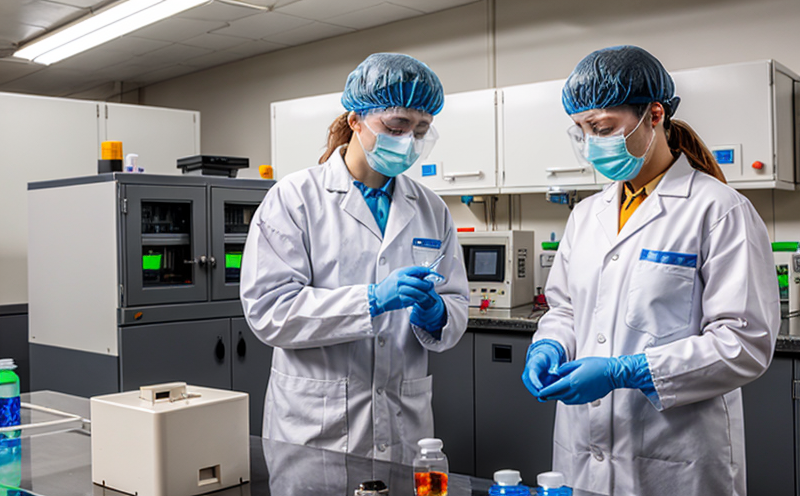EN 16284 Furan Detection in Nutritional Drinks
The European standard EN 16284 sets forth a method for determining furan levels in nutritional drinks, which is crucial given the potential health risks associated with this compound. Furans are unintentional by-products of thermal processing and can form during high-temperature cooking or sterilization processes. Elevated levels of furans have been linked to various health issues including cancer risk, particularly when consumed over an extended period.
Compliance with EN 16284 is essential for manufacturers of nutritional drinks as it ensures product safety and protects consumer health. The standard provides a structured approach to detecting furan in these products, enabling producers to implement effective quality control measures and ensure adherence to regulatory requirements. This method not only helps in maintaining the integrity of the brand but also fosters trust among consumers.
The testing process outlined in EN 16284 involves several critical steps. Initially, a representative sample is drawn from the production batch or stock. Once collected, the sample undergoes rigorous preparation to ensure it reflects the true furan content without any contamination. This may involve dilution if necessary and thorough mixing to achieve uniformity.
For accurate detection, specialized analytical instruments are employed. Liquid chromatography-tandem mass spectrometry (LC-MS/MS) is commonly used due to its high sensitivity and selectivity in identifying furan compounds. The sample is first prepared by extracting the furan from the matrix using appropriate solvents followed by derivatization if required for better detection.
The extracted furan is then introduced into the LC-MS/MS system where it undergoes separation, ionization, and mass analysis. Identification of furan is achieved through comparison with reference standards and calibration curves established during method validation. Results are typically reported in parts per billion (ppb) or similar units depending on the sensitivity required for specific applications.
Compliance with EN 16284 also includes thorough documentation practices to substantiate adherence to the standard throughout every stage of testing, from sampling to final reporting. This ensures that all stakeholders can verify compliance easily and facilitates traceability should any issues arise post-production.
Achieving compliance involves continuous monitoring and improvement efforts aimed at reducing furan formation during processing. Implementing best practices such as optimizing cooking temperatures and durations, improving hygiene standards within manufacturing facilities, and selecting raw materials carefully contribute significantly towards achieving this goal.
In summary, EN 16284 provides a robust framework for detecting furans in nutritional drinks. By adhering to its stringent guidelines, manufacturers can produce safe and high-quality products while safeguarding public health interests.
Why It Matters
The importance of detecting furan levels in nutritional drinks cannot be overstated due to the potential adverse effects on human health. Furans are known carcinogens that pose significant risks when consumed chronically. Compliance with EN 16284 ensures that manufacturers maintain strict quality controls, thereby protecting consumers from these hazards.
From a regulatory perspective, adhering to this standard helps companies avoid costly fines and penalties associated with non-compliance. It also enhances brand reputation by demonstrating commitment to safety standards, which is increasingly important in today’s competitive market environment.
Achieving compliance fosters trust between producers and consumers, encouraging loyalty among customer bases who value health-conscious products. Moreover, it opens up opportunities for international trade as many countries adopt similar regulations based on internationally recognized standards like those provided by ISO or EN.
For quality managers and R&D engineers involved in nutritional drink production, understanding the nuances of EN 16284 is vital. It allows them to stay ahead of industry trends, implement innovative solutions more effectively, and make informed decisions regarding process optimization and ingredient selection. In essence, mastering this standard equips professionals with valuable tools necessary for ensuring product safety and regulatory compliance.
Applied Standards
The European standard EN 16284 specifies the procedure for determining furan in liquid beverages intended for human consumption, including nutritional drinks. This method is applicable to various types of beverages such as sports drinks, energy drinks, and meal replacement shakes among others.
To perform this test accurately, laboratories must follow specific procedures outlined in EN 16284 which include sample preparation techniques, extraction methods, derivatization steps if necessary, instrumental analysis using LC-MS/MS, and result reporting formats. These detailed instructions ensure consistent results across different labs thus promoting reliability within the testing process.
The standard also emphasizes the importance of method validation before conducting any actual tests to guarantee accuracy and precision. Validation includes establishing calibration curves, assessing linearity over a wide range, determining limits of detection (LOD) and quantitation (LOQ), evaluating repeatability, reproducibility, and robustness.
Additionally, EN 16284 provides guidelines on sample handling from collection through final analysis including storage conditions to minimize degradation or contamination risks. Properly preserved samples are crucial for obtaining reliable data which can impact decision-making processes related to quality assurance programs.
Use Cases and Application Examples
The application of EN 16284 extends beyond mere laboratory testing; it plays a pivotal role in ensuring product safety throughout the entire supply chain. Here are some practical use cases:
- Production Line Monitoring: Continuous monitoring during production can help identify potential issues early on, allowing for corrective actions to be taken promptly.
- Batch Release Testing: Before releasing batches into distribution channels, thorough testing ensures they meet all specified criteria set forth by EN 16284.
- R&D Innovations: New formulations or processes can undergo rigorous evaluation using this standard to ensure they do not introduce unwanted furans into the final product.
- Supply Chain Audits: Suppliers may be required to submit samples for testing according to EN 16284 as part of routine audits conducted by purchasing departments.
An example scenario involves a large-scale beverage manufacturer who sources raw materials globally. By adhering strictly to EN 16284, they can ensure that all incoming batches meet the required furan limits regardless of their origin. Another instance could be an R&D lab developing new energy drinks aimed at enhancing performance without compromising safety.
These real-world applications highlight how EN 16284 serves as a cornerstone for maintaining product quality and regulatory compliance across diverse industries.





